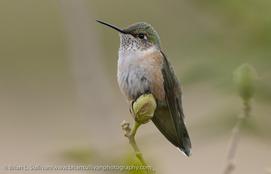BROAD-TAILED HUMMINGBIRD CO-203
Climbing the Rockies: juniper habitat, Temple Canyon Park, Canyon City, Colorado
June 8, 8:27 a.m.
Sunrise at 5:37 a.m.
You will know them by their wing sounds before any other clue.
But I'm curious about how rapidly birds beat their wings when they fly. So I measure:
At first there are 10 visible beats that I can see in the sonagram over 0.58 seconds, for a rate of 17 wing beats per second. That's too slow for a hummingbird!
Next are 7 major beats in 0.41 seconds, for a rate of 17. At least he's consistent. But in between each of those major beats are two minor sounds, each no doubt indicating an additional wing beat, so now I measure 3 x 7/0.41 = 51 beats/second. That's more like the rate of a flying hummingbird.
In his second major burst of wing sounds (at 0:04), when he's flying away I count 10 beats/0.23 seconds, which calculates to 43 beats/second. And in his third major burst of wing sounds (at 0:05), still flying away, there are also 10 beats/0.23 seconds, again 43 beats/second.
Fascinating: I conclude that in normal flight he beats his wings 43 times per second. But during displays, or special flights, he can beat up to 51 times/second. I don't think he would stay airborne for long at 17 beats/second, so I'm guessing that he somehow chooses, for whatever reason, to make the wing sound with his feathers every third beat then.
Background
a single meow of a spotted towhee.

Photo by Brian L. Sullivan
